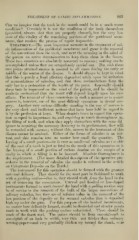Page 953 - My FlipBook
P. 953
TREATMENT OF CALCIC INFLAMMATION. 963
Can we imagine that the teeth in the mouth could be in a much worse
condition ? Certainly it is not the condition of the teeth themselves
(provided, always, that tiiey are properly cleaned), but the very low
state of the vitality of the remaining portions of the peridental mem-
brane, that renders the process of repair impossible.
Treatment.—The most important measure in the treatment of cal-
cic inflammation of the peridental membrane and gums is the removal
of the concretions from the teeth, and next the arousing in the mind of
the patient an active determination to keep them clean in the future.
These two measures are absolutely necessary to success ; nothing can be
accomplished unless they are scrupulously carried out. But with these
two points attained success is assured in all cases during the early or
middle of the course of the disease. It should always be kept in mind
that this is purely a local affection dependent solely upon the irritation
of accumulations of calculus, and that these accumulations form the
only bar to a restoration of the health of the parts. Plspecially should
these facts be impressed on the mind of the patient, and he should be
made to understand that the result will depend largely upon his own
efforts. The removal of these concretions in such a manner as to assure
success is, however, one of the most difficult operations in dental sur-
gery. Another very serious difficulty standing in the way of success is
the very slack and inefficient notions that have been held in regard to
it by the profession at large. When dentists learn to regard tliis opera-
tion as equal in importance to, and requiring as much thoroughness as,
the filling of teeth, and when they apply themselves with the same dil-
igence to acquiring the necessary dexterity in its performance, they will
be rewarded with success ; without this, success in the treatment of this
disease cannot be attained. Either of the forms of calculus is an irri-
tant, and this remains true no matter how small the quantity. The
leaving of a small portion—be it ever so small—of calculus on the side
of the root of a tooth is just as fatal to the result of this operation as is
the leaving of a small portion of carious dentine on the margin of a
cavity in which a filling is to be inserted. Absolute thoroughness is
the requirement. (For more detailed description of the operative pro-
cedures in the removal of calculus the reader is referred to the article
on Calcareous Deposits on the Teeth.)
The instruments for tliis operation should be formed with the greatest
care and delicacy. They should for the most part be fashioned to work
with a jmshing motion—that is, they should work from the hand in the
act of removing the concretions. Curved and hooked or hoe-shaped
instruments formed to work toioard the hand with a jndling motion may
be of service in the removal of the bulk of the larger concretions of
salivary calculus, but they are of inferior value in the removal of the
last portions of the deposits or for serumal calculus that is deposited
high up under the gum. For this purpose all the hooked instruments,
no matter how delicately formed, should be discarded and slender points
made to work with the jmshing motion substituted. These should be
made of the finest steel. The points should be from one-sixteenth to
one-eighth of an inch in width, very thin—not thicker than ordinary
writing-paper—and very gradually thicken up toward the shank, so as


